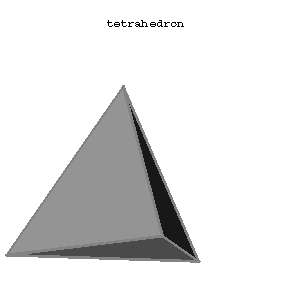Difference between revisions of "Tetrahedron"
From Encyclopedia of Mathematics
(Importing text file) |
(TeX) |
||
| Line 1: | Line 1: | ||
| − | The convex hull of a set of four points, not all in one plane. In particular, a regular tetrahedron is one of the five types of Platonic polyhedra (cf. [[Platonic solids|Platonic solids]]). A tetrahedron has 4 (triangular) faces, 6 edges and 4 vertices (at each of which 3 edges meet). If | + | {{TEX|done}} |
| + | The convex hull of a set of four points, not all in one plane. In particular, a regular tetrahedron is one of the five types of Platonic polyhedra (cf. [[Platonic solids|Platonic solids]]). A tetrahedron has 4 (triangular) faces, 6 edges and 4 vertices (at each of which 3 edges meet). If $a$ is the length of an edge of the regular tetrahedron, then its volume is | ||
| − | + | $$\frac{a^3\sqrt2}{12}\approx0.1179a^3.$$ | |
A tetrahedron is a triangular pyramid. | A tetrahedron is a triangular pyramid. | ||
| Line 12: | Line 13: | ||
====Comments==== | ====Comments==== | ||
| − | A solid tetrahedron is also called a | + | A solid tetrahedron is also called a $3$-simplex. The Schläfli symbol of a tetrahedron is $\{3,3\}$. |
====References==== | ====References==== | ||
<table><TR><TD valign="top">[a1]</TD> <TD valign="top"> H.S.M. Coxeter, "Introduction to geometry" , Wiley (1969) pp. 149; 185</TD></TR><TR><TD valign="top">[a2]</TD> <TD valign="top"> H. Senechal (ed.) G. Fleck (ed.) , ''Shaping space'' , Birkhäuser (1988) pp. 5; 7; 100; 133; 175</TD></TR></table> | <table><TR><TD valign="top">[a1]</TD> <TD valign="top"> H.S.M. Coxeter, "Introduction to geometry" , Wiley (1969) pp. 149; 185</TD></TR><TR><TD valign="top">[a2]</TD> <TD valign="top"> H. Senechal (ed.) G. Fleck (ed.) , ''Shaping space'' , Birkhäuser (1988) pp. 5; 7; 100; 133; 175</TD></TR></table> | ||
Latest revision as of 16:15, 11 April 2014
The convex hull of a set of four points, not all in one plane. In particular, a regular tetrahedron is one of the five types of Platonic polyhedra (cf. Platonic solids). A tetrahedron has 4 (triangular) faces, 6 edges and 4 vertices (at each of which 3 edges meet). If $a$ is the length of an edge of the regular tetrahedron, then its volume is
$$\frac{a^3\sqrt2}{12}\approx0.1179a^3.$$
A tetrahedron is a triangular pyramid.

Figure: t092510a
Comments
A solid tetrahedron is also called a $3$-simplex. The Schläfli symbol of a tetrahedron is $\{3,3\}$.
References
| [a1] | H.S.M. Coxeter, "Introduction to geometry" , Wiley (1969) pp. 149; 185 |
| [a2] | H. Senechal (ed.) G. Fleck (ed.) , Shaping space , Birkhäuser (1988) pp. 5; 7; 100; 133; 175 |
How to Cite This Entry:
Tetrahedron. Encyclopedia of Mathematics. URL: http://encyclopediaofmath.org/index.php?title=Tetrahedron&oldid=18299
Tetrahedron. Encyclopedia of Mathematics. URL: http://encyclopediaofmath.org/index.php?title=Tetrahedron&oldid=18299
This article was adapted from an original article by BSE-3 (originator), which appeared in Encyclopedia of Mathematics - ISBN 1402006098. See original article